Abstract
The sequence of the structural gene encoding the Legionella pneumophila extracellular zinc metalloprotease has been determined and was found to possess a single large open reading frame (ORF) of 1,629 nucleotides (nt). This ORF was preceded by consensus promoter (TTAACT . . . 17 nt . . . TATAAC) and ribosome-binding (TAAGGAG) sequences. The deduced polypeptide contained a putative signal sequence and a total of 543 amino acid residues with a computed molecular size of 60,775 daltons, substantially larger than the observed 38,000 daltons of the native and recombinant proteins. A homology search revealed extensive amino acid identity with Pseudomonas aeruginosa elastase, a protein that is also encoded by an ORF substantially larger than that predicted for the mature size of the protein. The structural identity between the L. pneumophila protease and P. aeruginosa elastase was most pronounced in the regions forming the enzymatic active site of elastase. Amino acid residues constituting the active-site cleft of elastase were greater than 75% conserved. Elastase residues that interact with and mediate proteolysis of substrate peptides were 100% conserved. Competitive inhibitors of elastase and the structurally and functionally related thermolysin (phosphoramidon and a phosphoramidate analog, Z-GlyP(O)Leu-Ala), were shown to be equally potent at inhibiting the proteolytic activity of the L. pneumophila protease. These inhibitor studies along with the amino acid sequence similarities provide strong evidence that the L. pneumophila protease and P. aeruginosa elastase share a similar molecular mechanism of proteolysis.
Full text
PDF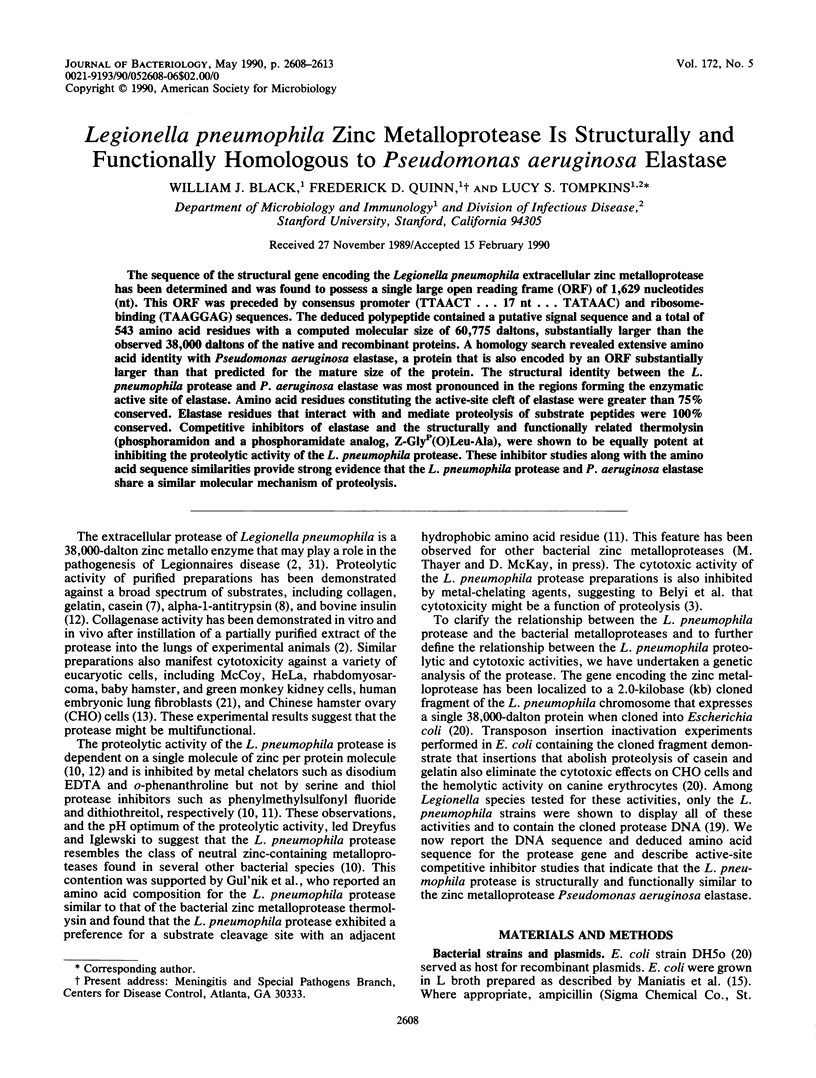
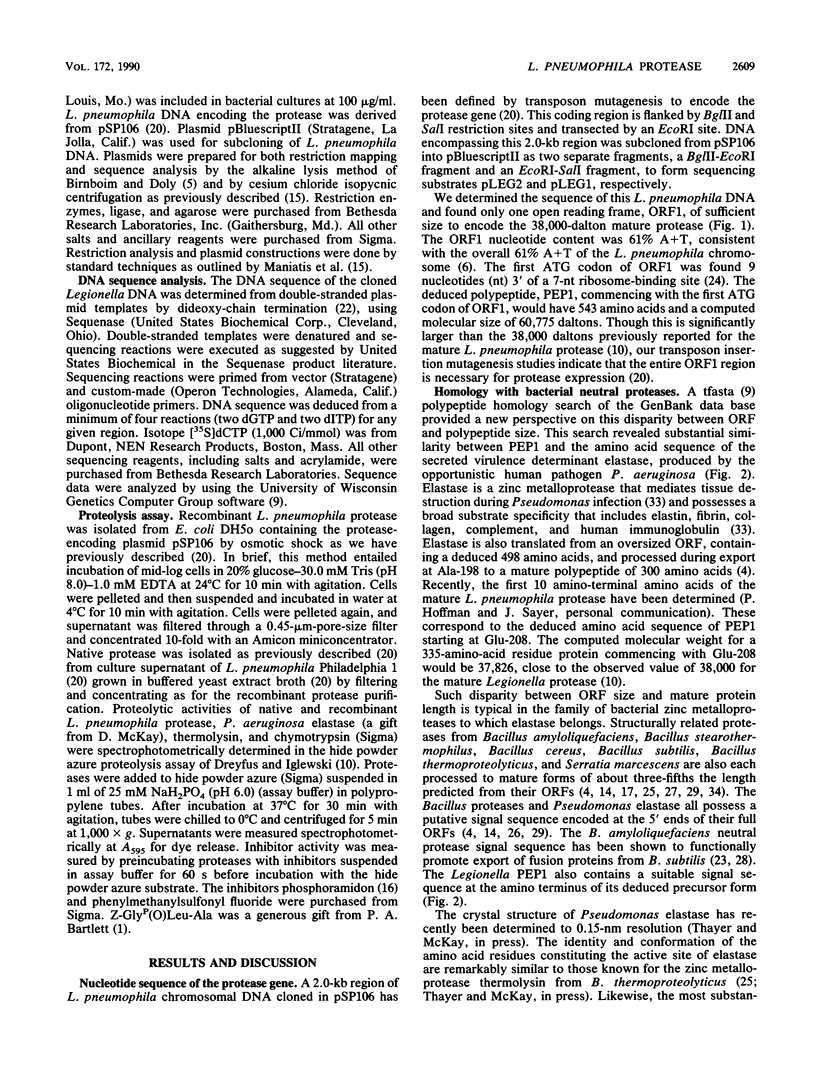
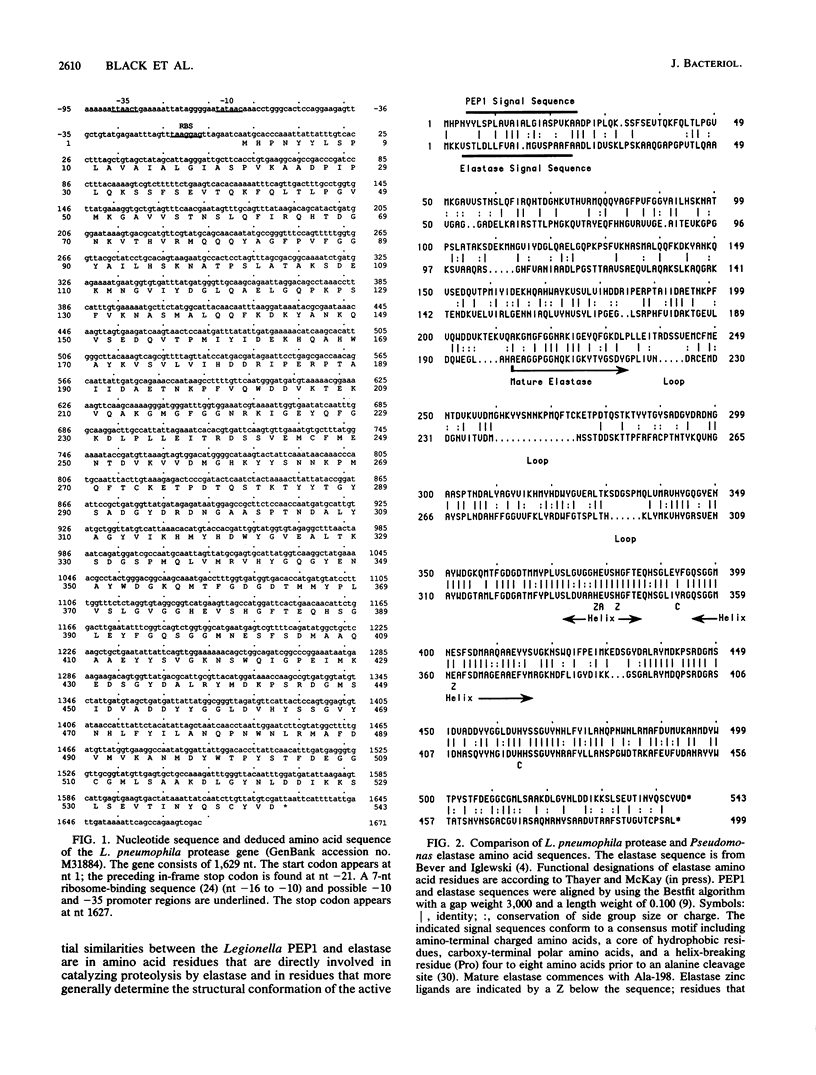
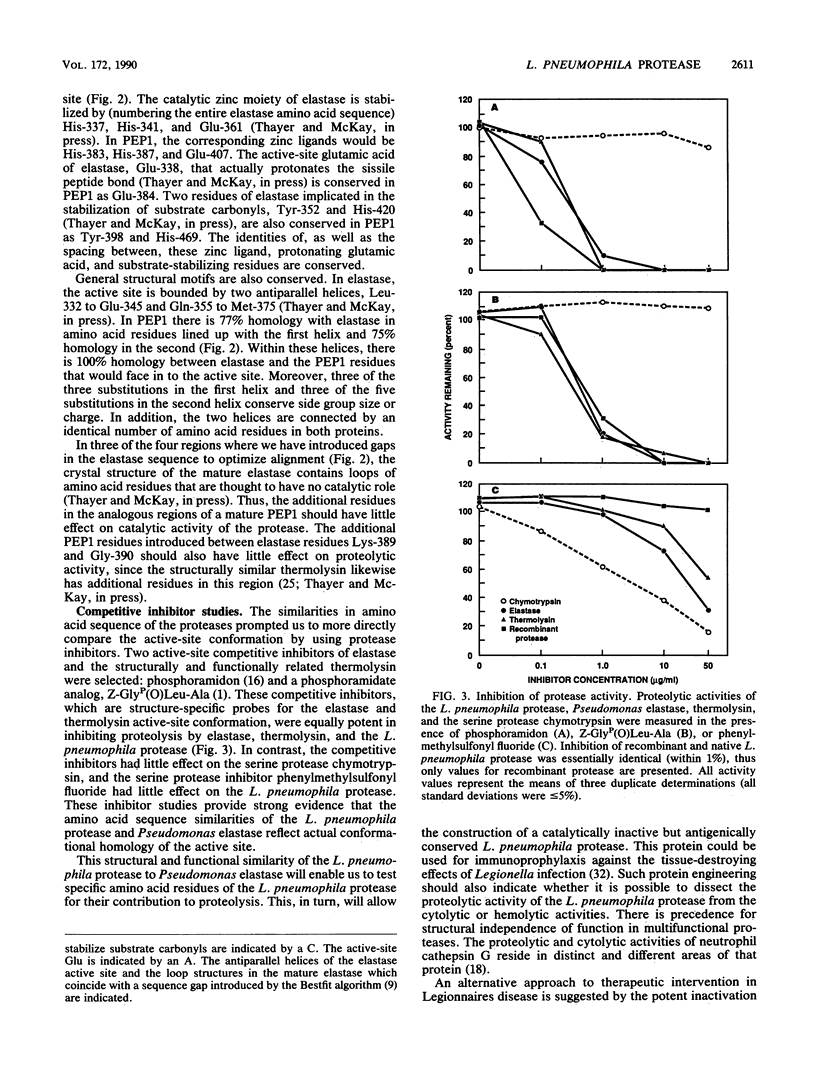
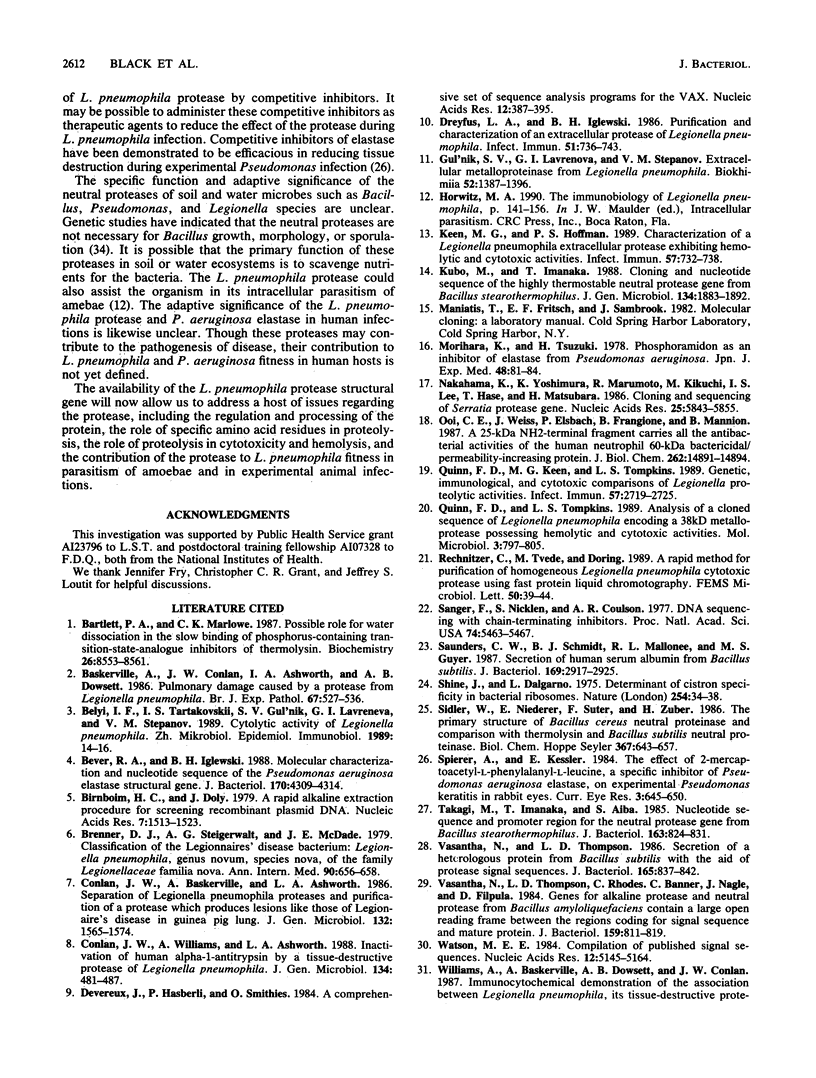
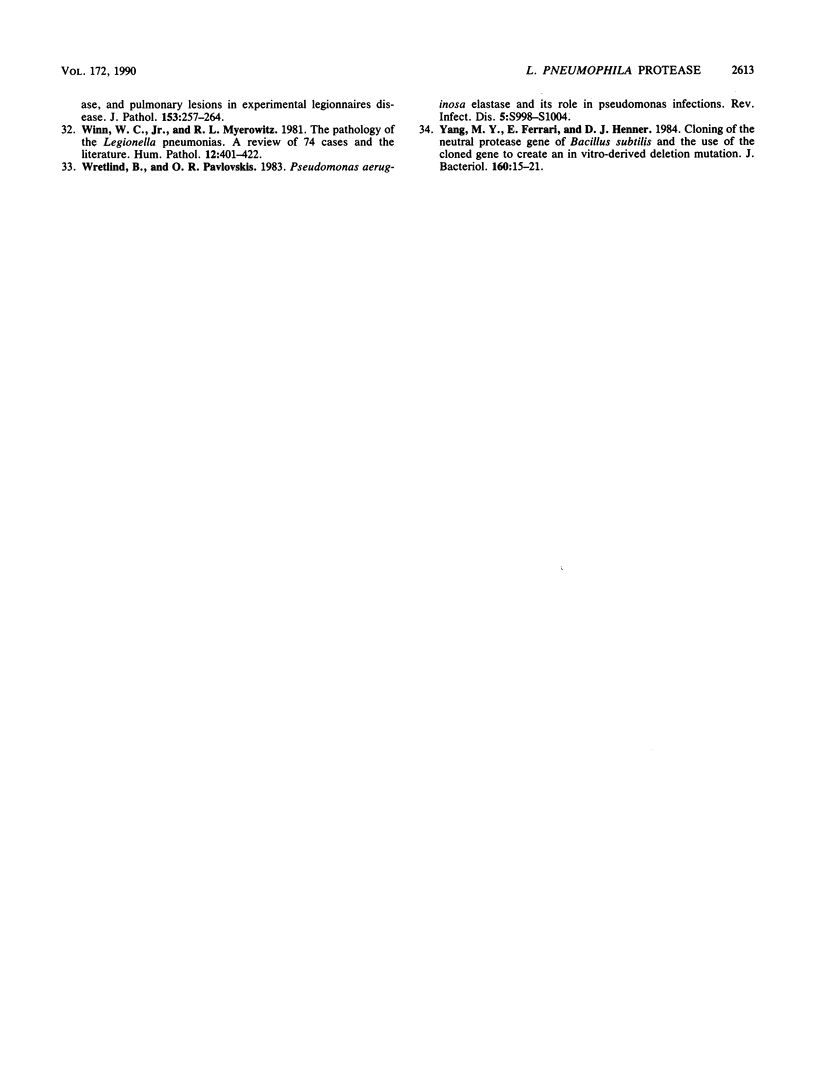
Selected References
These references are in PubMed. This may not be the complete list of references from this article.
- Bartlett P. A., Marlowe C. K. Possible role for water dissociation in the slow binding of phosphorus-containing transition-state-analogue inhibitors of thermolysin. Biochemistry. 1987 Dec 29;26(26):8553–8561. doi: 10.1021/bi00400a009. [DOI] [PubMed] [Google Scholar]
- Baskerville A., Conlan J. W., Ashworth L. A., Dowsett A. B. Pulmonary damage caused by a protease from Legionella pneumophila. Br J Exp Pathol. 1986 Aug;67(4):527–536. [PMC free article] [PubMed] [Google Scholar]
- Belyi Iu F., Tartakovskii I. S., Gul'nik S. V., Lavreneva G. I., Stepanov V. M. Priroda tsitoliticheskoi aktivnosti Legionella pneumophila. Zh Mikrobiol Epidemiol Immunobiol. 1989 Feb;(2):14–16. [PubMed] [Google Scholar]
- Bever R. A., Iglewski B. H. Molecular characterization and nucleotide sequence of the Pseudomonas aeruginosa elastase structural gene. J Bacteriol. 1988 Sep;170(9):4309–4314. doi: 10.1128/jb.170.9.4309-4314.1988. [DOI] [PMC free article] [PubMed] [Google Scholar]
- Birnboim H. C., Doly J. A rapid alkaline extraction procedure for screening recombinant plasmid DNA. Nucleic Acids Res. 1979 Nov 24;7(6):1513–1523. doi: 10.1093/nar/7.6.1513. [DOI] [PMC free article] [PubMed] [Google Scholar]
- Brenner D. J., Steigerwalt A. G., McDade J. E. Classification of the Legionnaires' disease bacterium: Legionella pneumophila, genus novum, species nova, of the family Legionellaceae, familia nova. Ann Intern Med. 1979 Apr;90(4):656–658. doi: 10.7326/0003-4819-90-4-656. [DOI] [PubMed] [Google Scholar]
- Conlan J. W., Baskerville A., Ashworth L. A. Separation of Legionella pneumophila proteases and purification of a protease which produces lesions like those of Legionnaires' disease in guinea pig lung. J Gen Microbiol. 1986 Jun;132(6):1565–1574. doi: 10.1099/00221287-132-6-1565. [DOI] [PubMed] [Google Scholar]
- Conlan J. W., Williams A., Ashworth L. A. Inactivation of human alpha-1-antitrypsin by a tissue-destructive protease of Legionella pneumophila. J Gen Microbiol. 1988 Feb;134(2):481–487. doi: 10.1099/00221287-134-2-481. [DOI] [PubMed] [Google Scholar]
- Devereux J., Haeberli P., Smithies O. A comprehensive set of sequence analysis programs for the VAX. Nucleic Acids Res. 1984 Jan 11;12(1 Pt 1):387–395. doi: 10.1093/nar/12.1part1.387. [DOI] [PMC free article] [PubMed] [Google Scholar]
- Dreyfus L. A., Iglewski B. H. Purification and characterization of an extracellular protease of Legionella pneumophila. Infect Immun. 1986 Mar;51(3):736–743. doi: 10.1128/iai.51.3.736-743.1986. [DOI] [PMC free article] [PubMed] [Google Scholar]
- Gul'nik S. V., Lavrenova G. I., Stepanov V. M. Vnekletochnaia metalloproteinaza Legionella pneumophila. Biokhimiia. 1987 Aug;52(8):1387–1396. [PubMed] [Google Scholar]
- Keen M. G., Hoffman P. S. Characterization of a Legionella pneumophila extracellular protease exhibiting hemolytic and cytotoxic activities. Infect Immun. 1989 Mar;57(3):732–738. doi: 10.1128/iai.57.3.732-738.1989. [DOI] [PMC free article] [PubMed] [Google Scholar]
- Kubo M., Imanaka T. Cloning and nucleotide sequence of the highly thermostable neutral protease gene from Bacillus stearothermophilus. J Gen Microbiol. 1988 Jul;134(7):1883–1892. doi: 10.1099/00221287-134-7-1883. [DOI] [PubMed] [Google Scholar]
- Morihara K., Tsuzuki H. Phosphoramidon as an inhibitor of elastase from Pseudomonas aeruginosa. Jpn J Exp Med. 1978 Feb;48(1):81–84. [PubMed] [Google Scholar]
- Nakahama K., Yoshimura K., Marumoto R., Kikuchi M., Lee I. S., Hase T., Matsubara H. Cloning and sequencing of Serratia protease gene. Nucleic Acids Res. 1986 Jul 25;14(14):5843–5855. doi: 10.1093/nar/14.14.5843. [DOI] [PMC free article] [PubMed] [Google Scholar]
- Ooi C. E., Weiss J., Elsbach P., Frangione B., Mannion B. A 25-kDa NH2-terminal fragment carries all the antibacterial activities of the human neutrophil 60-kDa bactericidal/permeability-increasing protein. J Biol Chem. 1987 Nov 5;262(31):14891–14894. [PubMed] [Google Scholar]
- Quinn F. D., Keen M. G., Tompkins L. S. Genetic, immunological, and cytotoxic comparisons of Legionella proteolytic activities. Infect Immun. 1989 Sep;57(9):2719–2725. doi: 10.1128/iai.57.9.2719-2725.1989. [DOI] [PMC free article] [PubMed] [Google Scholar]
- Quinn F. D., Tompkins L. S. Analysis of a cloned sequence of Legionella pneumophila encoding a 38 kD metalloprotease possessing haemolytic and cytotoxic activities. Mol Microbiol. 1989 Jun;3(6):797–805. doi: 10.1111/j.1365-2958.1989.tb00228.x. [DOI] [PubMed] [Google Scholar]
- Rechnitzer C., Tvede M., Döring G. A rapid method for purification of homogeneous Legionella pneumophila cytotoxic protease using fast protein liquid chromatography. FEMS Microbiol Lett. 1989 May;50(1-2):39–44. doi: 10.1016/0378-1097(89)90455-2. [DOI] [PubMed] [Google Scholar]
- Sanger F., Nicklen S., Coulson A. R. DNA sequencing with chain-terminating inhibitors. Proc Natl Acad Sci U S A. 1977 Dec;74(12):5463–5467. doi: 10.1073/pnas.74.12.5463. [DOI] [PMC free article] [PubMed] [Google Scholar]
- Saunders C. W., Schmidt B. J., Mallonee R. L., Guyer M. S. Secretion of human serum albumin from Bacillus subtilis. J Bacteriol. 1987 Jul;169(7):2917–2925. doi: 10.1128/jb.169.7.2917-2925.1987. [DOI] [PMC free article] [PubMed] [Google Scholar]
- Shine J., Dalgarno L. Determinant of cistron specificity in bacterial ribosomes. Nature. 1975 Mar 6;254(5495):34–38. doi: 10.1038/254034a0. [DOI] [PubMed] [Google Scholar]
- Sidler W., Niederer E., Suter F., Zuber H. The primary structure of Bacillus cereus neutral proteinase and comparison with thermolysin and Bacillus subtilis neutral proteinase. Biol Chem Hoppe Seyler. 1986 Jul;367(7):643–657. doi: 10.1515/bchm3.1986.367.2.643. [DOI] [PubMed] [Google Scholar]
- Spierer A., Kessler E. The effect of 2-mercaptoacetyl-L-phenylalanyl-L-leucine, a specific inhibitor of Pseudomonas aeruginosa elastase, on experimental Pseudomonas keratitis in rabbit eyes. Curr Eye Res. 1984 Apr;3(4):645–650. doi: 10.3109/02713688409003066. [DOI] [PubMed] [Google Scholar]
- Takagi M., Imanaka T., Aiba S. Nucleotide sequence and promoter region for the neutral protease gene from Bacillus stearothermophilus. J Bacteriol. 1985 Sep;163(3):824–831. doi: 10.1128/jb.163.3.824-831.1985. [DOI] [PMC free article] [PubMed] [Google Scholar]
- Vasantha N., Thompson L. D., Rhodes C., Banner C., Nagle J., Filpula D. Genes for alkaline protease and neutral protease from Bacillus amyloliquefaciens contain a large open reading frame between the regions coding for signal sequence and mature protein. J Bacteriol. 1984 Sep;159(3):811–819. doi: 10.1128/jb.159.3.811-819.1984. [DOI] [PMC free article] [PubMed] [Google Scholar]
- Vasantha N., Thompson L. D. Secretion of a heterologous protein from Bacillus subtilis with the aid of protease signal sequences. J Bacteriol. 1986 Mar;165(3):837–842. doi: 10.1128/jb.165.3.837-842.1986. [DOI] [PMC free article] [PubMed] [Google Scholar]
- Watson M. E. Compilation of published signal sequences. Nucleic Acids Res. 1984 Jul 11;12(13):5145–5164. doi: 10.1093/nar/12.13.5145. [DOI] [PMC free article] [PubMed] [Google Scholar]
- Williams A., Baskerville A., Dowsett A. B., Conlan J. W. Immunocytochemical demonstration of the association between Legionella pneumophila, its tissue-destructive protease, and pulmonary lesions in experimental legionnaires' disease. J Pathol. 1987 Nov;153(3):257–264. doi: 10.1002/path.1711530310. [DOI] [PubMed] [Google Scholar]
- Winn W. C., Jr, Myerowitz R. L. The pathology of the Legionella pneumonias. A review of 74 cases and the literature. Hum Pathol. 1981 May;12(5):401–422. doi: 10.1016/s0046-8177(81)80021-4. [DOI] [PubMed] [Google Scholar]
- Wretlind B., Pavlovskis O. R. Pseudomonas aeruginosa elastase and its role in pseudomonas infections. Rev Infect Dis. 1983 Nov-Dec;5 (Suppl 5):S998–1004. doi: 10.1093/clinids/5.supplement_5.s998. [DOI] [PubMed] [Google Scholar]
- Yang M. Y., Ferrari E., Henner D. J. Cloning of the neutral protease gene of Bacillus subtilis and the use of the cloned gene to create an in vitro-derived deletion mutation. J Bacteriol. 1984 Oct;160(1):15–21. doi: 10.1128/jb.160.1.15-21.1984. [DOI] [PMC free article] [PubMed] [Google Scholar]


